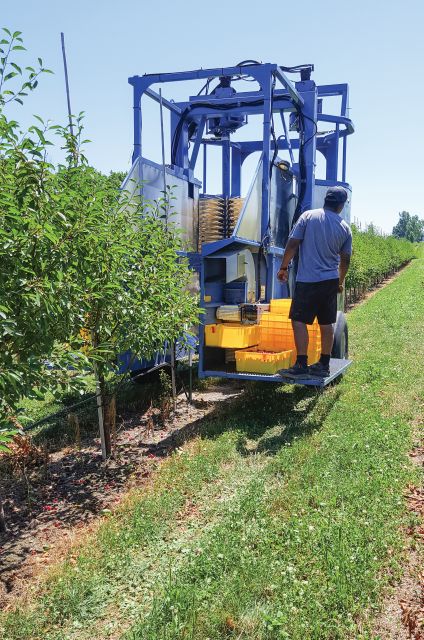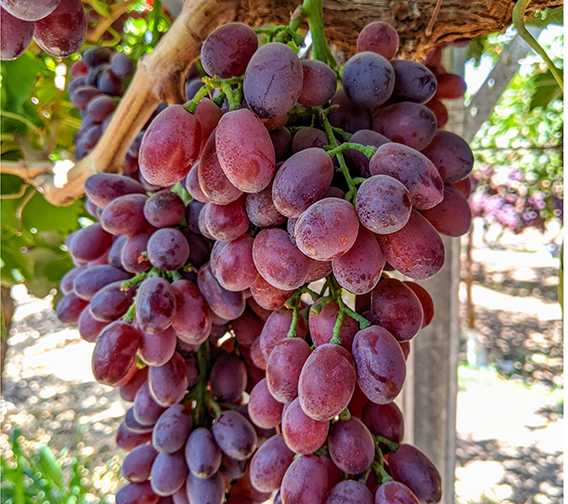Going High Density In Tart Cherries

Ken Engle modifed a berry harvester to increase production in his high-density tart cherry system. (Photo Credit: Emily Pochubay)
When you drive through the Traverse City area as tart cherries are ready for harvest, from the road the trees take on a red hue — each tree is brimming with bright red fruit. It’s no secret tart cherries are synonymous with Northwest Michigan. In fact, 70% of the nation’s tart cherries are grown in Michigan.
It’s also no secret that the returns tart cherry growers get for their crop is not the same as fresh-market sweet cherries or other tree fruit crops. To offset lower returns, growers are eyeing alternative means to get their trees into production at a faster rate, while keeping hand labor costs down.
“What I want is fruit growers to be profitable,” Ken Engle, a tart cherry grower in Northwest Michigan,” says. “We’ve got young growers in our areas that need ways to make money so they can be in the fruit business, and from the prices that I hear talked about for this year’s crop, I don’t think it sounds very good.”
Standard Production Problems
Which is exactly what motivated Engle, whose Engle Ridge Farm is in Grand Traverse County, MI. He had seen the high-density plantings of Ron Perry of Michigan State University. Engle also understood just how long it takes to get tart cherries into standard production for typical shake-and-catch harvesting.
“If we were going to plant them in the ground and wait the amount of time it would take for our orchard to get into full production, I’d be pretty old,” he says.
So six five years ago — after seeing high-density apple production during International Fruit Tree Association tours — he decided his best bet would be to adopt a high-density system for ‘Montmorency’ trees on Mahaleb. After consulting with researchers and using some analytic software, Engle determined a 12-by-5-foot spacing was the best fit for his orchard.
“The set of criteria I have for this is doing as much mechanically as we can, because of the value of tart cherries, I don’t want to be putting a lot of hand labor into it,” Engle says.
Too Tall For Berry Unit
When he was evaluating berry harvesters to use in the harvest of his cherries, he quickly determined his tree height was too tall for the standard machines commercially available.
“The trees need to be about 10 feet tall in order to have the bearing surface to get the production you want,” Engle says. “We knew that we would have to modify something on our own.”
After buying a heavy-duty used machine in Louisiana, Engle worked with a local fabricating shop to raise the machine 3 feet to fully accommodate his trees. He says the price of this harvester was half of what it would be for a shaker.
“One of the considerations we had with this machine was we had also planted [hard] cider apples in a tall spindle system,” he says. “It needed to be a certain height to fit that system.”
Engle was able to use his machine this season, and he says it worked better than expected. He says it goes about 1 mile per hour, and he saw no damage to his trees and irrigation system from the machine.
“All the things that we worried about ended up not being a problem,” he says.
Constantly Adjusting
However, Engle admits some adjustments will need to be made for next season — such as more fingers on the rotary tines to extend to the complete height of his trees. He also says he has to develop a system for conveying the cherries once they’re harvested into a cherry tank or bins, or something.
Engle also says there is a learning curve with high-density trees, and keeping the trees productive must be a focus.
“This whole idea of high-density sour cherries is relatively new – the difference is with cherries we keep growing new wood and renewing the wood to have cherry production,” he says.
Engle also says there is great concern within the tart cherry industry about the threat of spotted wing drosophila (SWD). Michigan is home to a lot of alternative hosts for SWD.
“We’re not sure whether the high-density trees are going to make it easier to manage SWD because the trees are more compact and easier to spray,” he says. “I don’t know if high density is for everyone to try right now, but I hope we can develop a system that works easily.”

Ken Engle’s Brownie Quad outfitted with a steering wheel and seat might be the only one of its kind. (Photo credit: Christina Herrick)
Custom Harvester
Modifying a berry harvester is not the only piece of equipment Ken Engle, a tart cherry grower in Northwest Michigan, has tinkered with.
Engle has also worked with Phil Brown Welding in Conklin, MI, to turn one of Brown’s Brownie Quads into a drivable hedger.
Engle says his Brownie is likely the only platform in existence with a steering wheel and a seat, which he said makes it easier for his workers to operate. It also has a 6-foot adjustable hedger bar mounted out front.Engle wants to keep the canopy about an arm’s length deep to get light penetration uniform. Tipping the trees at the proper time in the growth cycle causes beneficial responses.
“We’re hoping to get more shoots and spurs to increase production,” he says.










